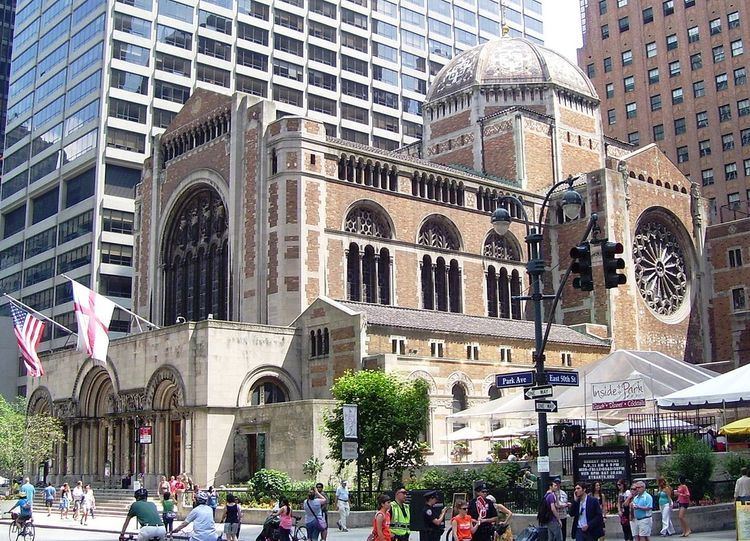Area 1 acre (0.40 ha) NRHP Reference # 80002719 Designated NHL October 31, 2016 Phone +1 212-378-0222 | Built 1903 Added to NRHP April 16, 1980 Opened 1903 | |
 | ||
Address 325 Park Ave, New York, NY 10022, USA Architectural styles Romanesque Revival architecture, Byzantine Revival architecture Similar St Thomas Episcopal Church, Cathedral of Saint John the, St Patrick's Cathedral, Grace Church, Church of the Heavenly Profiles | ||
St. Bartholomew's Church, commonly called St. Bart's, is a historic Episcopal parish founded in January 1835, and located on the east side of Park Avenue between 50th and 51st Street in Midtown Manhattan, in New York City.
Contents
On October 31, 2016, the St. Bartholomew's Church and Community House complex was designated a National Historic Landmark.
Former structures
The congregation's first location was opened for service in January 1835, in a plain church at the corner of Great Jones Street and fashionable Lafayette Place.
The second location, built from 1872 to 1876 at the southwest corner of Madison Avenue and East 44th Street, was designed by James Renwick, the architect of St. Patrick’s Cathedral, in the Lombardic style. The building was embellished in 1902–1903 with a triple French Romanesque Revival portal by Stanford White, who took as his inspiration the church of Saint-Gilles, Gard, between Arles and Nîmes, which White had admired in 1878; the sculptures in the tympana are Renaissance-inspired. The portal was paid for by the family of Cornelius Vanderbilt II as a memorial; Vanderbilt's father, William H. Vanderbilt, had sold the site to the church. The magnificent bronze doors, with bas-reliefs in panels depicting episodes from the Old and New Testaments, were carried out by some of New York's established sculptors: Andrew O'Connor, working freely under the general direction of Daniel Chester French, executed the main door; the south door was executed by Herbert Adams, the north door by Philip Martiny.
Present structure
The current church was erected in 1916–17. The original freely handled and simplified Byzantine Revival design by Bertram Goodhue was called "a jewel in a monumental setting" by Christine Smith in 1988. Goodhue modified his design in response to the requirement that the old church portal, beloved by the parishioners, be preserved, with its bronze doors, from the Madison Avenue building and re-erected on the new site.
The foundation stone of Goodhue's original design, a vast, unified barrel-vaulted space, without side aisles or chapels and with severely reduced transepts, was laid 1 May 1917 and the construction was sufficiently far along for the church to be consecrated in 1918; its design was altered during construction, after Goodhue's sudden, unexpected death in 1924, by his office associates, in partnership as Mayers, Murray and Philips; they were engaged in erecting the community house, continuing with the same materials, subtly variegated salmon and cream-colored bricks and creamy Indiana limestone; they designed the terrace that still provides the equivalent of a small square, surrounded by the cliff-like facades of Midtown commercial structures (illustration, upper right); in summer, supplied with umbrellas and tables, it becomes the outside dining area for the restaurant, Inside Park. They also inserted the "much discussed" dome, tile-patterned on the exterior and with a polychrome Hispano-Moresque interior dome, which substituted for the spire that had been planned but never built. Completed in 1930, the church contains stained-glass windows and mosaics by Hildreth Meiere, and a marble baptismal font by the Danish follower of Canova, Bertel Thorvaldsen. St. Bartholomew's, completed by 1930 at a cost of $5,400,000, is one of the city's landmarks. For long one of New York's wealthiest parishes, St. Bart's is known for a wide range of programs. It draws parishioners from all areas of New York City and surroundings. It is the final resting place for actresses Lillian Gish (1893–1993), Dorothy Gish (1898–1968), and their mother Mary Gish (1876–1948).
Landmark status
Saint Bartholomew's Church and Community House was designated a landmark by the New York Landmarks Preservation Commission in 1967, a move opposed at the time by the rector and vestry. Beginning in 1981, St. Bartholomew's found itself the subject of a much-publicized case concerning air rights in the highly-competitive New York real estate market clashing with historical preservation. The parishioners wanted to replace the community house and open terrace with a speculative high-rise commercial structure that would re-capitalize the parish's depleted funds; following a series of public hearing the Landmarks Preservation Commission turned down the plans for a fifty-nine story office building.
The case, St. Bartholomew's Church v. New York Landmarks Preservation Commission, raised as a constitutional issue the question whether churches and religious buildings should be exempt from historic ordinances. In 1989, the U.S. District Court for the Southern District of New York rejected the parish's claim, upholding the constitutionality of the Landmarks Law as applied to property owned by religious groups. The U.S. Court of Appeals for the Second Circuit affirmed this decision in 1990, and the U.S. Supreme Court denied certiorari (i.e., declined to hear the appeal) in 1991. It was a victory for landmark preservation.
Music
St. Bartholomew's is noted for its pipe organ, the largest in New York and one of the ten largest in the world. One of the church's former choir-directors was the famous conductor Leopold Stokowski, who was brought from Europe by St. Bart's; he was followed by the organist-choirmaster David McKinley Williams. Another of the church's music directors was Harold Friedell, the well-known composer and Juilliard educator. The church's choir has achieved distinction under the direction of conductors such as William Trafka and James Litton. The Chorister Program has also had success in bringing together children ages 6–18 to sing in the church, and has been featured on shows such as The Today Show and Good Morning America.
